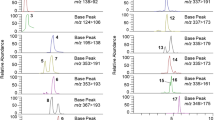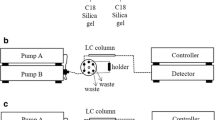Abstract
How much caffeine does one ingest when drinking a simple cup of coffee in Portugal? The study presented herein tried to answer this question through the assessment of caffeine content of commercially available espresso coffee samples, both caffeinated and decaffeinated, using a high-performance liquid chromatography assay. Caffeine was rapidly separated from the sample matrix using a RP-18 column (250 × 4 mm i.d., 5 μm). The flow rate was 1.0 mL/min and the mobile phase consisted of water acidified with 5% of orthophosphoric acid/methanol (35:65, v/v). Caffeine was detected directly at 273 nm. The assay was validated for linearity, lower limit of quantification and limit of detection, precision, accuracy, and stability. Seventeen different brands of caffeinated coffee and six of decaffeinated coffee were analyzed. As for capsule coffee, eight caffeinated and two decaffeinated blends were analyzed. The caffeine content of caffeinated coffee varied from 53.8 ± 5.9 to 141.3 ± 5.3 mg/cup, whereas for caffeinated capsule coffee caffeine concentrations ranged from 45.0 ± 5.3 to 60.8 ± 6.2 mg/cup. As for decaffeinated coffee, caffeine concentrations ranged from 0.96 ± 0.04 to 3.9 ± 0.1 mg/cup and for decaffeinated capsule coffee from 0.93 ± 0.04 to 1.2 ± 0.1 mg/cup.

Similar content being viewed by others

References
Bispo MS, Veloso MC, Pinheiro HC, De Oliveira RS, Reis JN, De Andrade JB (2002) Simultaneous determination of caffeine, theobromine, and theophylline by high-performance liquid chromatography. J Chromatogr Sci 40:45–48
Campa C, Doulbeau S, Dussert S, Hamon S, Noirot M (2005) Diversity in bean caffeine content among wild coffea species: evidence of a discontinous distribution. Food Chem 91:633–637. doi:10.1016/j.foodchem.2004.06.032
Desbrow B, Hughes R, Leveritt M, Scheelings P (2007) An examination of consumer exposure to caffeine from retail coffee outlets. Food Chem Toxicol 45:1588–1592. doi:10.1016/j.fct.2007.02.020
Diário da República (2001) I Série—A, Decreto-Lei no. 124/2001, 90, 17/Abril, 2211–2213
Evans RL, Siitonen PH (2008) Determination of caffeine and sympathomimetic alkaloids in weight loss supplements by high-performance liquid chromatography. J Chromatogr Sci 46:61–67
European Parliament (1999) Directive 1999/4/EC of the European Parliament and of the Council of 22 February 1999 relating to coffee extracts and chicory extracts. Amended by Official Journal Regulation (EC) No. 1882/2003 of the European Parliament and of the Council of 29 September 2003
Food and Drug Administration (2001) U.S. Department of Health and Human Services, Guidance for Industry, Bioanalytical Method Validation, BP
Food Standards Agency (2004) Survey of caffeine levels in hot beverages: food surveys. Food Standards Agency, UK
International Conference on Harmonisation (ICH) (2007) Validation of analytical procedures: text and methodology ICH Q2 (R1). Available at http://www.ich.org/LOB/media/MEDIA417.pdf
McCusker RR, Goldberger BA, Cone EJ (2003) Caffeine content of specialty coffees. J Anal Toxicol 27:520–522
McCusker RR, Fuehrlein B, Goldberger BA, Gold MS, Cone EJ (2006a) Caffeine content of decaffeinated coffee. J Anal Toxicol 30:611–613
McCusker RR, Goldberger BA, Cone EJ (2006b) Caffeine content of energy drinks, carbonated sodas, and other beverages. J Anal Toxicol 30:112–114
Pena A, Lino C, Silveira MIN (2005) Survey of caffeine levels in retail beverages in Portugal. Food Addit Contam 22(2):91–96. doi:10.1080/02652030500037886
Rodrigues CI, Marta L, Maia R, Miranda M, Ribeirinho M, Máguas C (2007) Application of solid-phase extraction to brewed coffee caffeine and organic acid determination by UV/HPLC. J Food Compos Anal 20:440–448. doi:10.1016/j.jfca.2006.08.005
Srdjenovic B, Djordjevic-Milic V, Grujic N, Injac R, Lepojevic Z (2008) Simultaneous HPLC determination of caffeine, theobromine, and theophylline in food, drinks, and herbal products. J Chromatogr Sci 46:144–149
Tzanavaras PD, Themelis DG (2007) Development and validation of a highthroughput high-performance liquid chromatographic assay for the determination of caffeine in food samples using a monolithic column. Anal Chim Acta 581:89–94. doi:10.1016/j.aca.2006.07.081
Acknowledgments
The authors acknowledge Maria Isabel Barroso, Florência Prata, Teresa Costa, Lídia Joaquim, and Maria Adriana Costa for their support in the laboratory.
Author information
Authors and Affiliations
Corresponding author
Additional information
All the authors have contributed equally to the work reported in this paper.
Rights and permissions
About this article
Cite this article
Candeias, S.X., Gallardo, E. & Matos, A.C. Caffeine Content of Retail Market Coffee in Portugal. Food Anal. Methods 2, 251–256 (2009). https://doi.org/10.1007/s12161-008-9058-8
Received:
Accepted:
Published:
Issue Date:
DOI: https://doi.org/10.1007/s12161-008-9058-8



